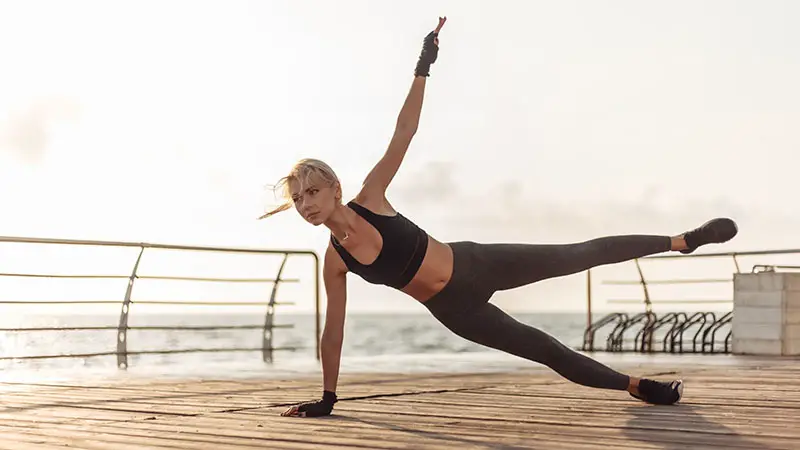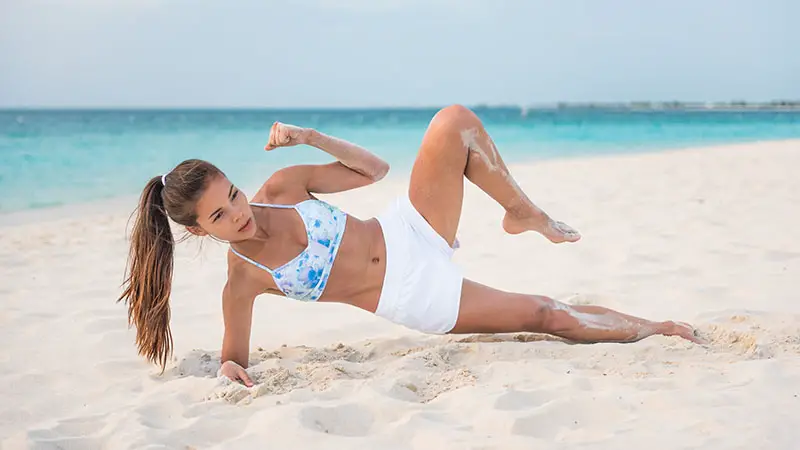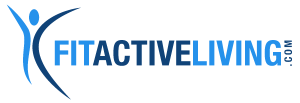Contents
- What is a Plank Exercise
- Different Types of Planks
- 1. High Plank
- 2. Forearm Plank
- 3. Side Plank
- 4. Push-Up Plank
- 5. Side Plank Hip Dip
- 6. Side Plank Leg Raise
- 7. Rotating Side Plank (Side Plank to Forearm Plank to Side Plank)
- 8. Plank Jacks
- 9. Plank Wiper
- 10. Shoulder Tap Plank
- 11. Reaching Plank
- 12. Rocking Plank
- 13. Side Plank Crunch
- 14. Spider-man Plank
- 15. Twisting Piston Plank
- 16. Side Plank Reach Through
- Plank Exercises For Beginners
- Plank Benefits For Weight Loss
What is a Plank Exercise

Most people think plank exercises just focus on your core, but they also engage the upper and lower body using over twenty muscles in your shoulders, arms, back, legs, glutes, and abdominals. As a calisthenic exercise, the plank is the starting point for various bodyweight exercises such as push-ups, burpees, and mountain climbers. By balancing your weight on your hand/forearms and toes, you activate large muscle groups in the abdominal area, including:
- Transversus abdominis
- Rectus abdominis
- Internal and External obliques
- Spinal Erectors
While many people fall back to old school sit-ups and crunches as their go-to core exercise, which are better suited for isolated conditioning, the plank allows for increased activation of multiple muscle groups and provides more functional strength benefits. Plank exercises have been proven to engage the core and supporting muscles with low compression forces. This is not the case with sit-ups and crunches, which can lead to immense pressre on your neck and lumbar spine, causing a high risk of injury. Planks are also beneficial for improving your posture, which comes into play when lifting weights or doing daily activities.
Different Types of Planks
1. High Plank
One of three basic planks that you will use to advance to more challenging planks.
- Start in a tabletop position with your shoulders in line with your wrists and your knees in line with your hips.
- Activating your abdominals, glutes, shoulders, and back, lifting off the ground, and extending your legs back to a straight line position
- If using a mirror or a partner, make sure that your butt isn’t raised and your hips aren’t dipping towards the ground.
- Imagine a board running straight from your head, down your back, butt, and legs (hence the word “plank”).
- Maintain a neutral position with your head and neck by focusing on the floor a few inches away from your fingertips.
- Execute for time
2. Forearm Plank
Another of the three basic planks that are used to advance to more challenging planks. Some may find this form easier to start from as you have the use of your forearm and elbows as opposed to just your hands.
- Start in a tabletop position, then lower your upper body so that you are resting on your forearms with your elbows in line with your shoulders, palms facing down (some people like to make fists, but do not clasp your hands together), and your forearms parallel to each other.
- Raise off your knees and step your feet back into a straight line, fully extended and slightly hip-width apart. The wider or more narrow your feet are, will make it easier or harder to balance.
- Avoid letting your hips drop or your butt elevate.
- Maintain a neutral head and neck position.
- Execute for time
3. Side Plank

The most challenging of the three basic types of planks. A side plank can be done with a straight arm or on your forearm. For this example, we will use a forearm plank.
- Start lying on one side, legs extended in a straight line, with your feet stacked on top of each other. You can change the exercise by placing your feet in front of each other rather than stacking.
- Prop your body up by leaning on your forearm with your elbow stacked under your shoulder and your hand extended in front of your body. Engage your core and glutes as you lift your hips off the floor.
- Place your opposite hand on your hip or you can raise it straight up in the air.
- Execute for time
IMPORTANT: Before moving on to any of the advanced types of planks, it is important that you can properly perform the three basic variations in order to prevent any potential injuries.
4. Push-Up Plank
High Plank to Forearm and Back. Sometimes referred to as “Up-Downs”. This type of plank will challenge your stability and weight distribution.
- Starting in a high plank position with your hands shoulder-width apart and shoulders stacked over your wrists. Extend your legs straight out behind you and engage your core as you would a regular high plank. Position your feet shoulder-width apart.
- Lower one arm down into a forearm plank position and then do the same with the other side into a full forearm plank position.
- Place your starting hand back on the floor and extend your arm. Repeat the same movement with your other arm.
- Repeat the movement, starting the exercise by lowering/raising the opposite hand first.
- Focus on not allowing your hips to roll from side to side.
- Execute for time or reps
5. Side Plank Hip Dip
This variation of the side plank focuses on the oblique muscles by adding a slight contraction and range of motion.
- Same directions as the basic forearm side plank
- Slowly dip your bottom hip towards the floor and then raise it back up.
- Lower and raise your body at the same tempo.
- Execute for reps
6. Side Plank Leg Raise

This type of plank can be done with a straight arm or on your forearm, with each variation challenging your balance, stability, and coordination. This variation will also target your hip abductors. For this example, we will use a forearm plank.
- Set up in the basic side plank position with your feet stacked on top of each other
- Make sure you have a straight line from your bottom foot through to your shoulder.
- Lift your top leg in a straight line slightly higher than your hip and lower it back down at the same tempo.
- Keep your feet flexed and place your free hand on your upper hip or in the air.
- Execute for reps.
7. Rotating Side Plank (Side Plank to Forearm Plank to Side Plank)
Also known as a rolling plank, this calisthenics variation engages your shoulder, lats, and oblique muscle groups.
- On your knees, cross your arms in front of you at shoulder height, one stacked on top of the other.
- Position yourself in a modified plank form with your legs extended straight out, feet hip-width apart.
- Roll onto one forearm into a proper side plank position, extend the top arm straight into the air with your lower hip up in the air.
- Slowly roll back into a forearm plank and roll to the opposite side.
- Do not allow your hips to sag during the transition from side to front to side.
- Keep your movement smooth
- Execute for reps.
8. Plank Jacks
A great way to add a cardiovascular workout and dynamic movement to your plank exercise. If the plank jack is too difficult, modify it by doing a single leg toe-tap plank. Both types of planks will work your hip abductors besides other muscle groups. Add resistance by placing an exercise band around your calves or thighs.
- Start in a traditional high plank position with your hands shoulder-width apart, wrists and shoulders stacked, and feet starting beside each other.
- As you would with a standing jumping jack, hop your feet out to the sides and back in repeatedly at a steady tempo.
- Keep your hips stable, do not raise your butt, keep a straight line from your crown to your feet.
- Execute for time or reps
9. Plank Wiper
If you are looking for an advanced variation of this plank, when you sweep your leg out to the side, tap your foot for a couple of reps to add an extra workout to your glutes and hips.
- Start in a traditional high or forearm plank position, with your feet hip-width apart.
- Slowly sweep (extend) one leg out to the side. Be mindful that you do not break form by dropping your hips or raising your butt.
- Return your leg to the starting position and repeat on the other side.
- If you have a hardwood floor, you can use a pair of sliders, a pillow, or a small towel to help with the sweeping motion.
- Work within your range of motion to extend your leg and foot parallel with your hips.
10. Shoulder Tap Plank

Adding a compound movement to the basic high plank exercise, this variation gives your arms an added workout, targeting your biceps, triceps, and shoulders as you shift your weight.
- Start in a high plank position with wrists and shoulders stacked, legs extended, feet hip-width apart
- Touch one shoulder with the opposite hand and return to the high plank position.
- Repeat the same movement with the other hand and shoulder.
- Breathe out on each shoulder tap.
- Maintain a flat back and do not allow your hips to rotate.
- Continue alternating for rep count
11. Reaching Plank
You can do this plank variation from a high plank or forearm plank position. Targeting the abdominals, shoulders, obliques, and lower back, this calisthenic exercise requires stability and balance.
- Start in a forearm plank position
- Extend one arm forward so that it becomes parallel with the ground. Then return to starting position. Focus on making all movements the same tempo.
- Repeat on the opposite side.
- Do not allow your hips to rotate as your arm extends forward.
- Use a wall, box, or target as your measured reaching point, so you make sure you get a full range of motion each time.
- Execute for reps
12. Rocking Plank
A great workout for your core and your shoulders, you can do this type of plank from a high plank or forearm plank position. For an advanced variation, perform this exercise on a Bosu or exercise ball or with a yoga block between your thighs.
- Start in a forearm plank position with your core engaged.
- While maintaining a straight back, raise slightly higher on both your elbows/forearms and toes.
- Shift your body back and forth two to four inches in a rocking motion. Allow your shoulders to move past your elbows.
- Execute at a smooth tempo for reps or time.
13. Side Plank Crunch

The side plank crunch is a cardiovascular exercise that strengthens the core, upper back, and shoulders. Performing this type of plank also engages hip flexors and challenges flexibility and stabilization.
- Start in a basic side plank position with your elbow stacked under your shoulder, legs extended and feet stacked on top of each other. If your foot stacking is an issue, you can stagger them.
- Place your top hand on the side of your head so your elbow is out at a 90-degree angle, or you can extend it overhead.
- Bend your top leg and raise it to meet your elbow as you lower your arm, executing a side crunch. Return to the starting position.
- Execute for reps
14. Spider-man Plank
Channeling one of the Marvel Universe’s most popular superheroes, you can do this type of plank from a high plank or forearm plank position. Besides strengthening your core, this exercise also helps improve hip mobility. For an advanced variation, you can add a Spider-Man push-up to your routine.
- Similar set up to the Plank Crunch.
- Rather than driving your knee straight forward, bring your leg slightly outside of your hip line and extend your knee towards the outside of the same elbow.
- Avoid twisting your hips or back.
- Execute for reps and/or time.
15. Twisting Piston Plank
Adding a cardiovascular movement to your abdominal workout, this challenging plank exercise, also known as the bunny-hop plank, can be done from a high plank or forearm plank position.
- Start in a forearm plank position.
- Jump your feet to one side of your body with a slight rotation in your lower body.
- Aim to have your knees parallel with your hip line and return to your starting position.
- Repeat on the opposite side.
- Work your way up to doing both sides in one continuous explosive motion.
16. Side Plank Reach Through
A great exercise for improving your strength, balance, and toning your love handles. This type of plank also works on your upper body flexibility.
- Start in a side forearm plank position with your shoulder over your planted elbow and your hips stacked.
- Feet can be on top of each other or in a staggered stance.
- Raise your top arm straight up in the air and then lower it and sweep it under your chest, rotating your torso and reaching your hand past your hip.
- Bring your top arm back through to the starting position
- Execute for reps.
Plank Exercises For Beginners
For someone new to doing plank exercises, some variations on this list could be a little overwhelming. However, you quickly find that once you master the basic variations and can extend your time, you will move to more challenging types of planks fairly quickly.
While there are stories about individuals holding types of planks for lengthy periods in challenges, anything over a few minutes does nothing for your muscles and can do more damage than good. Aim to start your basic high or forearm plank for a fifteen-second interval and then build from there, adding five to ten seconds. If you cannot maintain a full plank, you can bring your knees to the ground until your core, arm, and back strength is at the point at which you can execute a proper plank.
As most types of planks are non-impact exercises and focus on the entire body, doing a seven-day or even a thirty-day plank challenge is a great way to improve your core strength, balance, stability, and posture. Whether you pull up a pre-made challenge from the internet or create one of your own (ideally 2-3 variations and 2-3 sets of each for a timed period) will help both beginners and experienced “plankers” develop a stronger body.
Plank Benefits For Weight Loss
As mentioned, a plank exercise, be it the basic or one of the advanced variations, will help you burn fat at a rapid pace as it involves many muscle groups and increases your metabolism at the same time. While a plank will not only help to burn the troubled areas around the abdomen, it also improves posture and flexibility, which leads to a tighter core. Although the number of calories burned during a one-minute basic plank is minimal (2-5 calories), a toned body with better posture will give the look and the feel of having lost weight.
